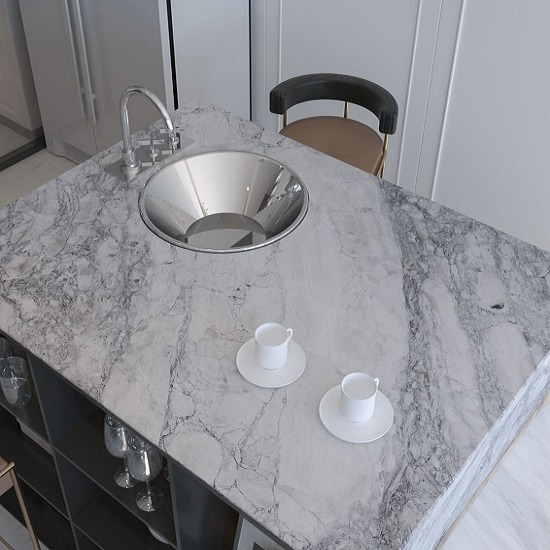Differentiating Between Carrara Marble and Arabescato Marble: Which is Better for Your Kitchen?

A stunning metamorphic rock, marble is formed when limestone is exposed to intense geological forces. The high heat and pressure over centuries led to the recrystallisation of calcite, thereby rendering a naturally smooth and polished appearance. Italian marble is hailed as the most luxurious, followed by marble varieties from Italy, Greece, China, and India. Carrara and Arabescato marble are two bestselling Italian marble varieties. Interestingly, both of these originate from the Carrara region of Italy. This region is home to the most premium marble deposits in the world.
Carrara and Arabescato Marble: A Comparative Look
Widely utilised for sculpture, decorative art, and architecture since antiquity, marble remains a popular choice in contemporary interior décor. From marble worktops and fireplaces to flooring, accent walls, vanity counters, furniture tops, and bathtubs, there are multiple ways to adorn your dream home with this mesmerising natural stone. The timeless elegance and decadence of marble are a class apart from other materials. As far as the most coveted marble varieties for UK homes are concerned, Carrara and Arabescato Marble are two names that stand out. Despite hailing from the same region, these are quite different from each other. If you are eager to design a new space or remodel your kitchen with stunning Italian marble, thoroughly understand the differences between Carrara and Arabescato Marble. Here is an insightful comparison:-
- Background Colour– A Carrara marble worktop is characterised by its typical faint and pearly white background. Although each slab has distinct hues, the backdrop is dominated by greyish undertones, the intensity of which can vary based on the natural formation process of the slab. On the other hand, Arabescato marble has a softer/purer white background. Amidst the swirling and web-like veins, the dreamy white pockets look like picturesque clouds.
- Veining Colour– Across most Carrara marble varieties, the veins are either light grey or dark grey. In some rare slabs, the veining colour can lean towards bluish-grey and blackish-grey. Arabescato marble has a wider range of veining hues. In some slabs, the veins are grey and beige, while in others, the veining colours like black and gold make an impressive appearance.
- Veining Patterns– Carrara marble patterns are usually subtle, linear, and nettle-like. An important reason for the popularity of the Carrara marble worktop is the overall consistency of the veining, which yields a classic, delicate, and uniform aesthetic appeal. The veins in Arabescato marble are mostly inconsistent. Sometimes, they resemble intricate branches and flowing rivers. In other slabs, they can have a jagged and whorled appearance. Furthermore, there are Arabescato marble variants that have web-like veins in a complex, criss-cross network.
- Overall Aesthetics- If you wish to install marble work surfaces with ethereal, calm, and homogenous aesthetics, the Carrara marble worktop is the best choice. For dimly lit or confined kitchen spaces, installing Carrara marble creates an aura of brightness and spaciousness. In stark contrast, Arabescato marble is hailed for its bold and dramatic visuals. Since the veins are more pronounced and complex, it exudes a striking look with a lot of movement, dynamism, and vigour.
- Uses/Applications- Since the aesthetic appeal of Carrara and Arabescato marble are poles apart from each other, their indoor installations are quite different. The elegant and understated look of Carrara marble makes it ideal for kitchen worktops, flooring, and bathroom fixtures. The robust eye appeal and intense aura of Arabescato marble are best suited for accent walls, designer furniture tops, fireplace surrounds, and other focal points in the house.
- Price- Carrara marble is usually priced lower as compared to Arabescato marble. But this depends on several factors, such as the colour, quality, veining type, and pattern consistency of the Carrara slabs. Whiter Carrara variants with lesser veining tend to be more expensive owing to higher demand. The prices of Arabescato marble also vary based on the veining patterns, colour, and heterogeneity. But in contrast to Carrara, Arabescato slabs with highly pronounced and visually striking veins usually fetch a higher price. Also, in terms of availability, Carrara is more easily found than Arabescato, which is rarer. Hence, the latter is priced higher.
Conclusion
The detailed comparison above leaves a pressing question wide open. Carrara or Arabescato marble, which is better for your kitchen and home? The answer is that both of these are equally luxurious and beautiful in their unique ways. You can revel in the tranquil and elegant splendour of your kitchen interiors with a lovely Carrara marble worktop and Carrara marble flooring. It is also the perfect choice for opulent staircases and ambient bathroom flooring. If you want to install a visually striking kitchen island, a spectacular fireplace, or a bold accent piece, then Arabescato is the right choice. Rather than making an impulsive purchase, you should weigh in the décor theme, colour of fixtures, lighting style, and other aesthetic requirements of your home interiors.



